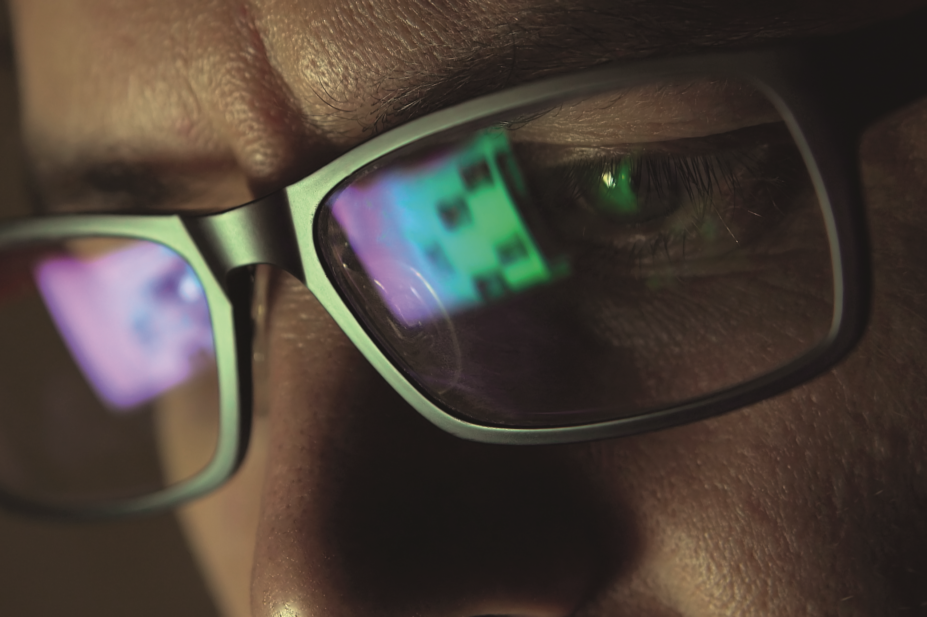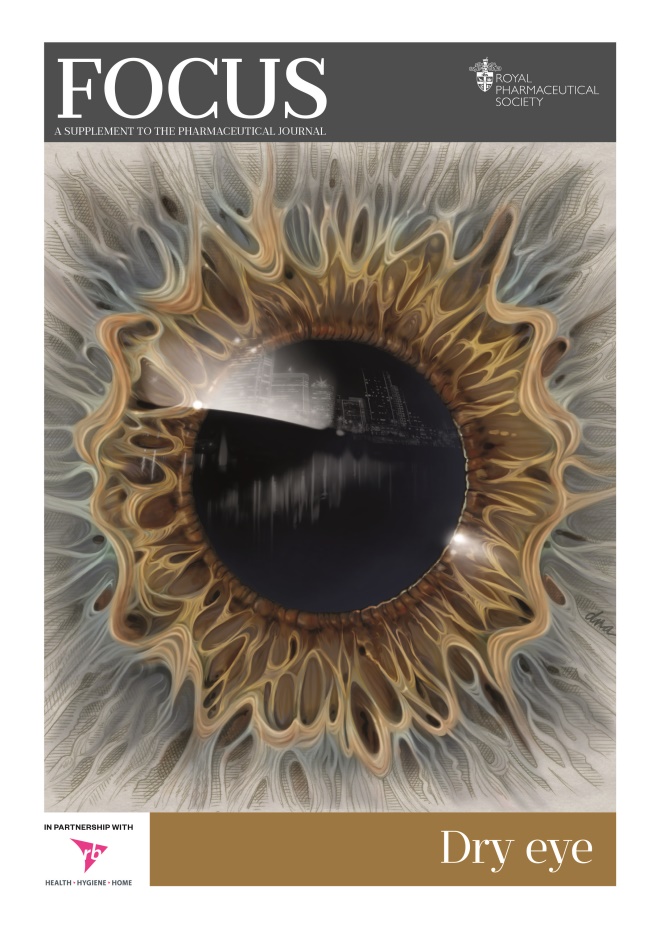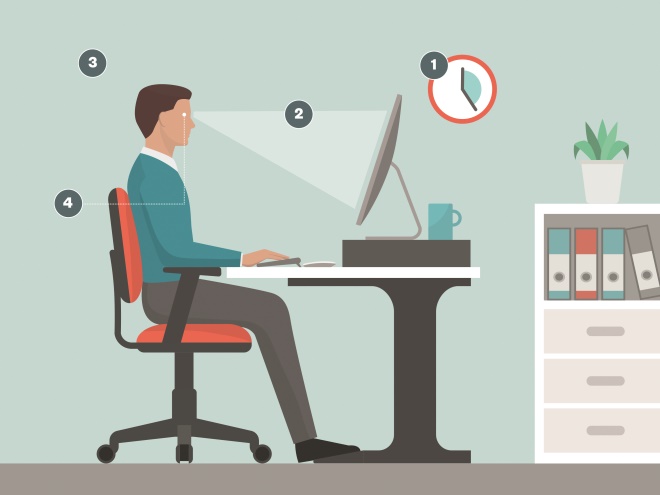
Shutterstock.com

In 2016, The Pharmaceutical Journal joined forces with UK health company RB to gauge how commonly dry eye is seen in the pharmacy and devised an independent editorial campaign to address the learning needs of pharmacists. This culminated in the publication of a print supplement ‘Focus: Dry eye’ and the production of The Pharmacy Learning Centre, a dedicated learning resource on the treatment, and management of eye conditions in pharmacy.
The prolonged use of digital devices has contributed to an increase in ‘computer-related’ ocular symptoms, called computer vision syndrome (CVS). CVS is often linked with dry eye disease, therefore, this article aims to build on the previous work and support pharmacists in discussing how lifestyle factors, including screen and device use, are associated with dry eye symptoms.
The prolonged use of digital devices has contributed to an increase of ‘computer-related’ ocular symptoms called computer vision syndrome (CVS), also known as digital eye fatigue. Research has found that around 75% of the population working in front of a screen for 6–9 hours daily complain of some ocular discomfort[1]
. Office-based studies have shown the prevalence of CVS to be higher in women than men[2]
, but similar between contact lens and spectacle wearers[3]
.
CVS broadly relates to ocular discomfort associated with prolonged computer use, but the time spent using screens, especially handheld devices, is increasing inexorably in our day-to-day activities, and avoiding screen use is not a possibility for many people. Indeed, it is estimated that children and young adults now spend around six hours a day using screens, including the use of multiple mobile devices[4]
.
This article aims to help pharmacists and healthcare professionals to identify the causes of ocular discomfort and how they can help patients manage their symptoms effectively.
Identifying CVS
Symptoms of CVS can be divided into four categories:
- Eye strain (asthenopia);
- Dry or painful eyes[5],[6]
relating to the ocular surface; - Difficulty focusing (visual blur);
- Or non-ocular symptoms.
Asthenopia can be defined through non-specific symptoms such as fatigue, pain in or around the eyes, headache, or even double vision. In patients with dry eye disease (see Box 1: ‘What is dry eye disease?’), the ocular surface dries out, causing scratchy, tired, irritated eyes, which may become worse with contact lens use[7]
. Refractive errors may result in complaints of blurred vision, slow focusing, double vision or difficulty focusing for close work (presbyopia). Non-ocular symptoms include neck, back or shoulder pain. Patients with CVS quite often have a range of symptoms from more than one category, and the pharmacist or pharmacy team may need to work out which of these may be associated with the condition in order to recommend the most appropriate treatment. In some patients, symptoms of dry eye disease may be accompanied by symptoms of anxiety relating to work, or even depression[8]
.
Box 1: What is dry eye disease?
The Tear Film and Ocular Surface Society (TFOS) International Dry Eye Workshop (DEWS) II report and guidelines, published in 2017, provides the following defintion for dry eye: “Dry eye is a multifactorial disease of the ocular surface characterised by a loss of homeostasis of the tear film, and accompanied by ocular symptoms, in which tear film instability and hyperosmolarity, ocular surface inflammation and damage, and neurosensory abnormalities play aetiological roles.”
There are two types of dry eye disease, which can occur individually or in combination:
- Evaporative dry eye is associated with an insufficient oily layer in the tear film, which can occur when the meibomian glands are damaged. Around 80% of patients with dry eye disease are affected by this type;
- Aqueous deficient dry eye, on the other hand, occurs when the lacrimal glands do not produce enough of the watery component of tears to maintain a healthy eye surface.
Sources: ‘Evidence-based understanding of dry eye disease in pharmacy: overview of the TFOS DEWS II report’ and ‘Dry eye: pathology and treatment types’
Differentiating the causes of CVS
Pharmacists may be the first point of contact for someone who is complaining of dry or tired eyes, therefore, they need to distinguish which factors might be at play for particular patients, and if screen use is one of the root causes.
Does the patient have difficulty focusing on the screen?
Refractive errors resulting from uncorrected long-sight (hyperopia), astigmatism or presbyopia may add to visual stress on the eye. While actual eyesight may be reasonable, correction of relatively small refractive errors can significantly reduce eye fatigue and other CVS symptoms[3]
. In particular, older people may have glasses for distance correction and/or reading glasses, but computer screens are at an intermediate distance, so neither lens enables comfortable focus. Consequently, the patient is uncomfortable in trying to accommodate (pull focus back) to see the screen clearly, or over-corrects by leaning forward to read the screen comfortably. Similarly, early middle-aged people (in their 40s) may struggle with prolonged reading, owing to presbyopia, and may need some “plus” lens correction. Patients with dry eye may also complain of blurred vision; however, unlike refractive error, this will usually improve with a blink.
Does the patient have double vision or need to close one eye to read comfortably?
Looking at objects close up (particularly handheld devices) stimulates convergence of the eyes, and difficulties with binocular vision can sometimes result in double vision, eye strain, fatigue and headaches. These symptoms are mostly transient because they ease after resting the eyes away from a digital device, and they are not a problem when looking into the distance. Intermittent double vision (diplopia) may be caused by convergence insufficiency, where the eyes do not converge as well as they should. This is associated with some medical conditions (e.g. Parkinson’s disease), but is not uncommon in the general population. More rarely, convergence excess can cause difficulties with binocular vision, but this usually occurs in children. Some adults have a latent squint, and sustained close work can also cause them to be symptomatic.
Do the patient’s eyes feel dry, tired and scratchy with initial good vision that blurs, which is helped by a blink?
Dry eyes may be described as gritty or sore with eye redness[6]
. Many aspects of computer use can predispose a person to dry eye disease, as well as having a reduced tear film, which may be because of too little water (aqueous deficiency) or increased evaporation because of a poor-quality tear film (evaporative dry eye) — see Box 1. For example, the tear film is replenished after every blink and studies have shown the blink rate to significantly reduce during long, concentrated hours on digital devices[9]
.
Furthermore, the environment (hot, dry air being circulated in sealed offices) adds to dry eye symptoms. Some studies suggest a strong correlation between ocular surface disease symptom scores and the frequency and severity of CVS episodes. The impact of dry eye discomfort can be greater among contact lens wearers because a well-functioning tear film plays a vital role in good lens fitting and movement. Older contact lens wearers tend to be most symptomatic as tear production generally decreases with age. Pharmacists should consider additional factors when advising contact lens wearers on treatments for dry eye, see ‘Treatments for dry eye disease’, later.
Differential diagnoses for dry eye disease are numerous. Information on the conditions and factors that can assist in differential diagnosis have been covered in a previous article (see [6]
).
Does the patient have neck/backache when using the computer?
Work stress and environmental working conditions may cause a person to adopt a posture in front of their screen to see better, while causing neck and back strain. The symptoms may present as neck, back or shoulder ache with transient headaches after long hours of computer use. Studies have shown optimal seating arrangements with a carefully considered distance from the screen, and altering image size to provide a more comfortable working environment, reduces symptoms of CVS[10]
(see Figure 1: ‘Computer vision syndrome — the environment’).

Figure 1: Computer vision syndrome — the environment
1. Screen time: individuals using screens should be told the 20:20:20 rule (i.e. every 20 minutes take a 20 second break and focus on an object 20 feet away).
2. Lighting, glare and screen configuration: abnormally bright or dim lighting, large windows or overhead lighting can form a washout effect on digital screens. The screen should also be positioned 35–40 inches from the eyes and display unit, where the centre of the screen should be placed 5–6 inches below eye level.
3. Airflow: air conditioning, with hot, dry air can cause dry eye symptoms to be worse, particularly in offices with no openable windows and with a high airflow.
4. Ocular features: persistant dry eye, blurred and double vision requires referal to an optometrist.
Treatments and recommendations for CVS
The pharmacist can advise patients suffering symptoms of CVS in modifying the environment where screen use is a problem (usually at work), and on the specific causes identified.
Take regular breaks
To ease symptoms of fatigue, everyone using screens should be advised to follow the 20:20:20 rule, whereby every 20 minutes, individuals should take a 20-second break and focus on an object 20 feet away. If the patient sounds like they have dry eye symptoms, while recommending the 20:20:20 rule, healthcare professionals may suggest to add blinking 20 times or advice to instil lubricating eye drops during these breaks. No one should continuously use a screen for hours at a time without frequent breaks. It may be worth recommending to patients to set an alarm every 20 minutes to remind them to take eye breaks.
Refer to an optometrist (blurred vision)
If difficulty in focusing is a problem, patients should be advised of the Health and Safety Executive guidance (i.e. that employers have to provide an eye test if an employee habitually uses display screen equipment as a significant part of their normal day-to-day work)[11]
. This is a full eyesight test by an optometrist (or a doctor), and if glasses are particularly required for screen use, the employer should pay for them[11]
. Optometrists will be able to prescribe appropriate strength glasses for the patient’s preferred working distance.
Refer to an orthoptist (double vision)
Convergence insufficiency symptoms can be eased with exercises: the patient should hold a small target at 50cm and slowly bring it towards the face, while trying to maintain single and focused vision. When the image splits into double, the object is moved away and the exercise is repeated. These exercises should be performed several times each day, with the aim of reducing the distance of the object before it splits into double vision. Referral to optometric or orthoptic care usually results in the patient being prescribed simple convergence exercises, and others such as stereogram cards to train their eye muscles at home, and sometimes glasses with a prism incorporated to make reading easier.
Treatments for dry eye disease
Mild aqueous deficient dry eye (keratoconjunctivitis sicca)
This can be treated with artificial tears and ocular lubricants[12]
. Hydroxypropyl methylcellulose (hypromellose) was the most commonly recommended ocular lubricant in 2015. However, a more viscous product such as carbomer 980 may be helpful for CVS patients because it can increase the time that moisture is retained. Moderate-to-severe forms may require prescribed topical anti-inflammatory medications (e.g. ciclosporin, non-steroidal anti-inflammatory eye drops or corticosteroid eye drops). Sodium hyaluronate is often recommended for treatment of more advanced dry eye disease.
Evaporative dry eye
Around 80% of patients with dry eye disease are affected by evaporative dry eye, making this the most prevalent form of the disease. The oily layer of the tear film is significantly reduced; this could be secondary to untreated anterior blepharitis or meibomian gland dysfunction. Ocular lubricants may be provided to ease symptoms. Further evidence is required to determine whether any of the tear film formulations available for evaporative dry eye are superior when compared with one another.
Administration
Treatments for dry eye disease are available in a range of formulations, including sprays, drops, gels and ointments. The proposed mechanism of action for newer lipid-containing artificial tear products involves stabilising the superficial lipid layer, thereby reducing tear film evaporation[12]
. These products may be particularly useful in patients with evaporative dry eye disease, caused by either environmental conditions or secondary to meibomium gland dysfunction. Furthermore, some liposomal sprays have been shown to improve ocular comfort, increase the lipid layer thickness and promote tear film stability, particularly those containing soya lecithin[12]
.
Patients should be advised of the various products, their potential modes of action and administration methods, to allow them to make an informed decision. Liposomal sprays may be beneficial for patients with reduced dexterity, who may also struggle with administering drops or for use in situations where administering drops may be less convenient. In addition, patients should be advised on appropriate lid hygiene, such as applying heat to the eyelids (either with a face cloth dipped in hot water or with commercial microwaveable eye masks), followed by lid massage with the face cloth, or cleansing the lid margins with lid-specific scrubs or cooled boiled water and a cotton bud.
Dosage
Many patients only apply treatments when the are symptomatic. This sporadic use of a treatment will provide temporary symptomatic relief, but will not improve long-term ocular health. Although manufacturers’ instructions should usually be followed, four times daily dosage is generally considered necessary for symptomatic improvement[12]
.
Further recommendations of dry eye treatments can be found in Evans and Madden[12]
.
Modify the environment
Lighting and glare: Abnormally bright or dim lighting from desk lamps, large windows or overhead lighting can form a washout effect on digital screens: a discomfort glare. After long hours of a glare effect, the patient can experience fatigue and musculoskeletal problems (from constantly changing posture in an attempt to see the screen better). Screen filters were popular with old-style computer monitors, but the brightness of modern LED screens can be easily adjusted. Spectacle coatings, such as an anti-reflective coating, are commonly advised to eliminate surface reflection. However, the evidence base to support their effectiveness is fairly limited.
Airflow: Air conditioning with hot, dry air can cause dry eye symptoms to worsen, particularly in offices with no openable windows and with a high airflow. It may be beneficial for patients to consider where they sit in an office, use humidifiers or open the window, if possible, and reduce airflow. Lubricant eye drops applied 3–4 times a day can help replenish the tear film for long hours in front of a computer screen.
Screen and seating configuration: The recommended screen positioning is a distance of 35–40 inches from the eyes and display unit where the centre of the screen should be placed 5–6 inches below eye level[10]
. Patients with postural problems can arrange an occupational health assessment at their workplace for proper seating posture advice and set-up.
Blue light: Blue light is the shortest wavelength in the visible spectrum and carries the highest amount of energy per photon. In theory, blue light has the ability to cause photochemical damages to the retina, which may result in damage to cells in the retina and cause premature death of the cells (apoptosis)[13]
. Screens, particularly LED screens, emit blue light; however, the eye filters much of this light out. Light damage is, in part, related to the brightness of the light, and modern screens emit very little light (hence no after-image) — the sun and blue-white LED bulbs emit much more blue light[14]
. Blue light filters will reduce glare so they may help some patients; however, there is no evidence that they are needed[15]
. Blue light suppresses the brain’s release of the hormone melatonin[16]
, a sleep-inducing hormone. Sleep patterns help regulate the body’s circadian rhythm, which is required to moderate the natural clock function on individual organs and control wakefulness. Consequently, pharmacists and healthcare professionals should advise patients to switch off all screens at least an hour before going to bed, to allow a better quality of sleep.
Additional useful resources:
RB provided financial support in the production of this content. The Pharmaceutical Journal retains full editorial control.
UK/O/0717/0033f
Reading this article counts towards your CPD
You can use the following forms to record your learning and action points from this article from Pharmaceutical Journal Publications.
Your CPD module results are stored against your account here at The Pharmaceutical Journal. You must be registered and logged into the site to do this. To review your module results, go to the ‘My Account’ tab and then ‘My CPD’.
Any training, learning or development activities that you undertake for CPD can also be recorded as evidence as part of your RPS Faculty practice-based portfolio when preparing for Faculty membership. To start your RPS Faculty journey today, access the portfolio and tools at www.rpharms.com/Faculty
If your learning was planned in advance, please click:
If your learning was spontaneous, please click:
References
[1] Blehm C, Vishnu S, Khattak A et al. Computer vision syndrome: a review. Surv Ophthalmol 2005;50(3):253–262. doi: 10.1016/j.survophthal.2005.02.008
[2] Ranasinghe P, Wathurapatha W, Perera Y et al. Computer vision syndrome among computer office workers in a developing country: an evaluation of prevalence and risk factors. BMC Res Notes 2016;9(1):150. doi: 10.1186/s13104-016-1962-1
[3] Rosenfield M. Computer vision syndrome: a review of ocular causes and potential treatments. Ophthalmic Physiol Opt 2011;31(5):502–515. doi: 10.1111/j.1475-1313.2011.00834.x
[4] Childwise. Connected Kids report. 2015. Available at: http://www.childwise.co.uk/reports.html#specialreports (accessed December 2017)
[5] Connelly D. Dry eye: pathology and treatment types. Pharm J 2016. doi: 10.1211/PJ.2016.20201582
[6] Wolffsohn J, Bilkhu P, Wolffsohn T et al. Identification of dry eye conditions in community pharmacy. Pharm J 2016. doi: 10.1211/PJ.2016.20201138
[7] Wolffsohn J & Craig J. Evidence-based understanding of dry eye disease in pharmacy: overview of the TFOS DEWS II report. Pharm J 2017. doi: 10.1211/PJ.2017.20203352
[8] Zheng Y, Wu X, Lin X et al. The prevalence of depression and depressive symptoms among eye disease patients: a systematic review and meta-analysis. Sci Rep 2017;7:46453. doi: 10.1038/srep46453
[9] Portello J, Rosenfield M & Chu C. Blink rate, incomplete blinks and computer vision syndrome. Optom Vis Sci 2013;90(5):482–487. doi: 10.1097/opx.0b013e31828f09a7
[10] Loh K & Redd S. Understanding and preventing computer vision syndrome. Malays Fam Physician 2008;3(3):128–130. PMID: 25606236
[11] Gov.uk. The Health and Safety (Miscellaneous Amendments) Regulations 2002. Available at: http://www.legislation.gov.uk/uksi/2002/2174/pdfs/uksi_20022174_en.pdf (accessed December 2017)
[12] Evans K & Madden L. Recommending dry eye treatments in community pharmacy. Pharm J 2016. doi: 10.1211/PJ.2016.20201430
[13] Lu B, Zhang P, Zhou M et al. Involvement of XBP1s in blue light-induced a2e-containing retinal pigment epithelium cell death. Ophthalmic Res 2017;57(4):252–262. doi: 10.1159/000452282
[14] Lougheed T. Hidden blue hazard? LED lighting and retinal damage in rats. Environ Health Perspect 2014;122(3):A81–A81. doi: 10.1289/ehp.122-a81
[15] Leung T, Li R & Kee C. Blue-light filtering spectacle lenses: optical and clinical performances. PLOS ONE 2017;12(1):p.e0169114. doi: 10.1371/journal.pone.0169114
[16] Emens J & Burgess H. Effect of light and melatonin and other melatonin receptor agonists on human circadian physiology. Sleep Med Clin 2015;10(4):435–453. doi: 10.1016/j.jsmc.2015.08.001



